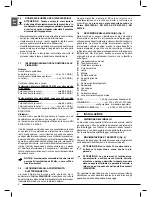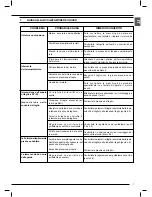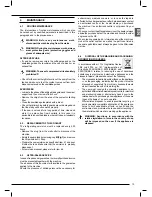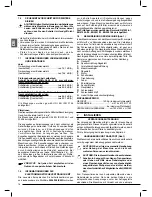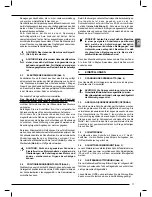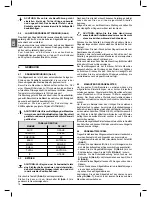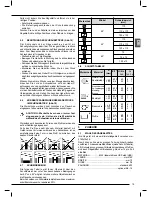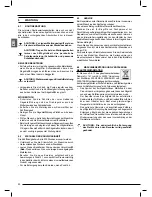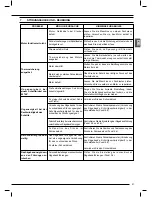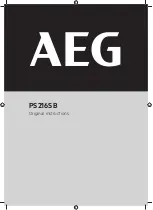
EN
10
Move the machine carefully and avoid sudden movements
which could unbalance the load and make it drop.
To remove the machine from the plate after packing removal,
loosen the fi xing screws but keep them should the machine
be transported for long stretches.
To transport the machine after freeing it from the plate,secure it
with resistant chains, ropes or braces, by passingthem through
the the eyebolts provided.
Then the machine must be lifted using a hoist of adequate
capacity or through another means suitable for this purpose.
WARNING: Do not lift the machine by the body D
(Fig. 1).
WARNING: Before lifting the machine, check that
the body is lowered and secured to the rest of the
structure by means of ropes or other claming means
as shown in Fig. 2
2.3
ELECTRICAL CONNECTIONS (Fig. 3)
Check that the mains to which the machine is connected is
earthed in accordance with current safety regulations and that
the power point is in good condition.
Connect a plug in compliance with safety rules to the end
of the mains cable of the machine, checking that the yellow/
green protective conductor is fi tted into the relative terminal
marked.
Check for the correct polarity of the motor through the blade
which must rotate
in the direction shown by the arrow
present on the machine body. If this is not the case, invert two
of the three cables of the plug.
Mount electric panel
A
into its seat on the pivoting support, and
fi nally secure it by tightening the supplied fi xing screws.
Remember that there should be a magnetothermic protective
device fi tted upstream of the mains to protect all the conductors
from short circuits and overloads.
This protective device should be selected according to the
electrical features of the machine stated on the motor.
In case of voltage failure in the system, you can wait for
the connection to be restored without danger of hazardous
conditions. In fact, the electric panel is equipped with a
reset function which prevents the machine from restarting
automatically.
To restart the machine, press the button
C (Fig. 4)
and then
push button
A
(Fig. 4) on the handgrip.
WARNING: Never change the overload cutout
setting to avoid overloads which could damage the
motor circuits and other mechanical members.
2.4
POSITION/WORK STATION (Fig. 5)
Position the machine by moving it as described in paragraph
2.2 on to a suffi ciently level bench, in such a way that the coolant
can refl ow in the collecting tank during the cutting operations.
Taking the ergonomic criteria into consideration, the ideal height
shall be that which enables you to position the table between
90 and 95 centimetres from the fl oor
(see Fig. 2)
.
Now, cut the strap which holds the body lowered and remove
the wooden cap which protects the machine while in transit.
CAUTION: Make sure that the machine is placed
in a working area with suitable environmental
conditions and lighting. The general conditions
of the working environment are of fundamental
importance for accident prevention.
Now lift the machine body and fi t the eye of spring
A
into its
location on pin
B
to prevent the spring from being expelled.
3 ADJUSTING
3.1
TENSION OF THE BLADE (Fig. 4)
Turn the handwheel clockwise
B
till the green indicator lights
C
up.
WARNING: The tensioning device is equipped
with a safety microswitch which prevents the
machine from operating till the blade is tensioned
correctly.
3.2
BAR STOP (OPTIONAL)
Use the bar stop supplied if you have to do several cuts on
pieces of the same length.
In this way you do not have to repeat the same measurement
each time.
Before adjust the bar stop, be sure the main switch is in 0
position.
Screw rod into the hole of the vice and fasten it with nut Slacken
the handwheel and place the stop at the correct distance from
the blade. Tighten handwheel again.
3.3 CUTTING
ANGLE
The machine can effect cuts ranging from 0° to 60°.
To unlock the body rotation, release the handle on the rotating
support.
3.4
CUTTING SPEED (Fig. 3)
Depending on the type of material and its section (see
CUTTING TABLE) you can choose two different cutting speed
30 or 60 m/min. by means of the switch
N
.
3.5
SLIDING BLADE GUIDE (Fig. 3)
The sliding blade guide
D
with integrated protection fi tted on
your sawing machine is used to perform the cut while guiding
the necessary part of the blade and fully protecting the part
not used in the cutting process. Slacken the knob
E
and slide
the blade guide
D
so as to move it closer to or further from the
part to be cut, as shown in the fi gure.
WARNING: If this adjustment is not done, the part
of the blade not used in the cutting process will be
exposed and this will create an extra risk of contact,
besides altering the quality of the cut.






